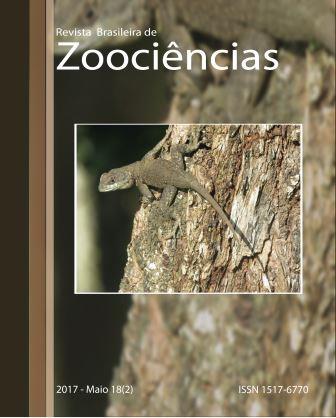Composition and structure of the helminth community of Columba livia (Gmelin, 1798) (Aves, Columbidae), in the municipality of Juiz de Fora, Minas Gerais state, Brazil
DOI:
https://doi.org/10.34019/2596-3325.2017.v18.24669Abstract
The objective of the present study was to describe the composition and structure of the helminth community present in domestic pigeons, in the municipality of Juiz de Fora, Minas Gerais, Brazil. The helminthological survey of 35 hosts revealed the presence of two digenetic trematodes, Tanaisia (Paratanaisia) bragai (prevalence 51.42%, mean intensity 288.8 ± 403.86 and mean abundance 148 ± 320.9) and T. inopina (prevalence 2.85% and mean abundance 0.68 ± 4.05); five cestodes, Raillietina allomyodes (prevalence 34.28%, mean intensity 6.66 ± 9.14 and mean abundance 2.28 ± 6.11), Raillietina sp. (prevalence 37.14%, mean intensity 9 ± 10.68 and mean abundance 3.34 ± 7.7), Skrjabinia bonini (prevalence 20%, mean intensity 2.14 ± 1.21 and mean abundance 0.42 ± 1), Skrjabinia sp.( prevalence 5.7%, mean intensity 6 ± 7 and mean abundance 0.34 ± 7) and Fuhrmanneta sp. (prevalence 2.85% and mean abundance 0.028 ± 0.16) and four nematodes, Baruscapillaria obsignata (prevalence 51.42%, mean intensity 29.72 ± 44.2 and mean abundance 15.28 ± 34.7); Ascaridia columbae (prevalence 51.42%, mean intensity 60.55 ± 79.88 and mean abundance 31.14 ± 64.2); Tetrameres fissipina (prevalence 14.28%, mean intensity 346.3 ± 504.4 and mean abundance 49.42 ± 212.1) and Synhimanthus (Dyspharynx) nasuta (prevalence 2.85% and mean abundance 0.028 ± 0.16). Among the examined hosts, 97.2 % were found parasitized by at least one helminth species. In accordance with the prevalence of each species T. bragai, A. columbae and B. obsignata were considered secondary species and T. inopina, T. fissipina, S. nasuta, S. bonini, Skrjabinia sp., R. allomyodes, Raillietina sp. and Fuhrmanneta sp. were considered satellite species. All the species exhibited aggregate distributions, which is the most common distribution pattern in helminth populations.Downloads
Downloads
Published
2017-07-10
Issue
Section
Artigos



